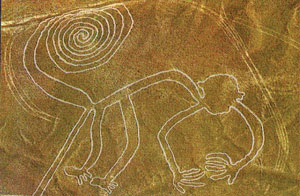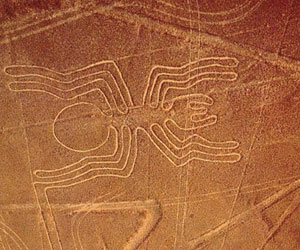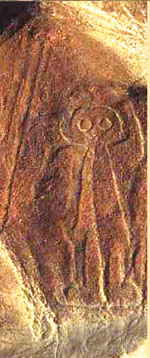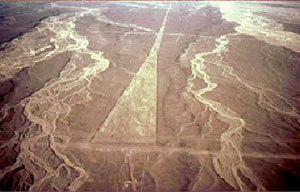|
Signs
Ďní wonders

The world we live in is full of mysteries and man has been searching
answers for them from time immemorial.
However, no matter how advanced science has become, there are still
many mysteries that cannot be unravelled by science. They continue to
baffle us.
|

The monkey |
|

The spider |
Remember we featured an article on November 2, 2008 under Signs íní
wonders about crop circles - strange shapes in crop fields that have
puzzled us for centuries? Today we decided to enlighten you about yet
another such phenomenon - the strange lines appearing in the desert of
Peru in South America.
The famous Nazca lines of Peru, which are associated with the Incan
civilization by some scientists, have become a great puzzle; no one has
yet come up with an acceptable theory as to why the Nazca Indians who
lived in this area between 300 BC and AD 800, have drawn them.
Before we get to the topic of the Nazca lines, let us enlighten you
about the place they are found in. The Nazca plain lies between the
great Andean Mountain and the Peruvian coast and is about 80 km (50
miles) in extent.
The Nazca desert is one of the driest deserts on Earth, with little
rain and wind. In fact, itís recorded that this area experiences only
about 20 minutes of rainfall for the entire year. So, itís not hard to
imagine how dry the place must be.
In addition to its dry weather, the Nazca plain is flat with no sand
and no wind. Scientists say this stable climatic condition is
responsible for the preservation of the famous Nazca geoglyps (as the
scientists call these series of lines) which stretches across the plain
encompassing nearly 500 square kilometres.
The plain is like a huge writing pad or canvas for artists who wanted
to leave their mark for posterity.
|

The astronaut |
Some say the series of lines are like a giant map or a blueprint left
by ancient artists for astronomers or aliens. The plain is popularly
referred to as Peruís scratchpad by many researchers.
Now, letís check out how these strange lines have been drawn by the
ancient people of the area, what they are like and what purpose they may
have served.
According to research carried out so far, researchers claim that this
montage of geometric formations called geoglyps are merely shallow
designs made on the ground by removing the top soil; the iron oxide
coated reddish pebbles on the top have been removed to create the
necessary lines or designs, exposing the light coloured sub-soil
beneath.
The contrasting colours make the lines sharp and visible to
onlookers. It is artistry of a different kind, with no painting or
carvings involved. And, as the plain is hardly exposed to elements such
as wind and rain, the lines have remained undisturbed all this time.
This assortment of simple to stylised geometrical lines comprise
perfectly straight lines, (some very narrow and running parallel, others
intersecting), spirals, triangles, zigzags, circles and trapezodial
zones with strange symbols and images.
|

The arrow-like triangle |
Scientists claim that in total there are about 1,300 km (800 miles)
of straight lines, with the largest straight line going nearly 16 km
across the plain.
The most amazing among these are the blomorphs - the animal and plant
figures which are grouped together. It is said that there are about 70
such figures including a killer whale, monkey, spider, flower, dog,
astronaut, pelican, tree, hands, lizard, star and birds.
The drawings of the spider, monkey and whale are considered to be
fascinating, but whatís most amazing is the huge drawing of a humming
bird. Perhaps, itís the largest drawing found anywhere in the world of
the smallest bird on Earth!
But, do you know that these intriguing Nazca geoglyps had not been
discovered until the 1930s? Since they were found, many scientists have
tried to study their meaning and come up with various theories. One such
person is Maria Reich. She spent over 50 years studying these drawings
and said ďwe will never know all the answers...Ē
As most of these signs could be clearly seen by air even though some
scientists say some are visible from closeby hills, two questions crop
up; that is, were the Nazca Indians capable of flying and if not, were
the drawings done for those who were able to see them from an aerial
point - such as aliens?
Many UFO experts believe that these lines and pictograms are landing
fields and landmarks for extraterrestrials. However, most scholars give
different interpretations to the big mystery - why are they there?
According to some, they may have been drawn as religious rituals.
Some say that while the geometrical lines may be connected to rituals to
obtain water, the symbols such as the spider, birds and plants may be
connected to fertility.
The other theories put forward are that they are giant astronomical
calendars, landing strips for spacecraft and signs for aliens or launch
sites for hot air balloons. Even though you may not pay much attention
to most of the possibilities for the existence of these drawings, the
theory of them being launch pads for hot air balloons is sure to draw
your attention.
How could they have known about hot air balloons, you may wonder.
Well, according to the experts, there is evidence indicating such a
possibility.
They state that pottery found in Peru show images of what may have
been kites or balloons. There are also some burn marks - blackened rock
at the end of the lines, that give weight to this theory.
But some are of the view that the burn marks in the desert may have
been caused by spacecraft. We will never know. Perhaps the discovery of
the lost city of the line buiders - Cahuachi may throw new light about
the Nazca people and unravel the mysteries of these famous Nazca lines.
|
Fact file
* The plateau on which these mysterious lines are etched, stretches
between Nazca and Palpa on the pampa -a large flat area off southern
Peru.
* Out of the 70 odd natural and human figures found on the Nazca
plain, the most famous is the figure of a man discovered in 1982.
It is 32 metres long and often called the astronaut. Some say itís an
alien while others say it could be an image of a god.
* The arrow-like triangle among the 900 odd geoglyphs is also a
drawing that has baffled many a researcher.
It is almost a kilometre in length and seems like a runway.
* The Nazca lines are not the only huge geoglyphs found in the world.
There are others in Egypt, Malta, Chilie, Bolivia and the US
(California).
But, the drawings at Nazca are special because they are so large,
with about 300 of them packed into an area of 500 square kilometres (310
square miles).
Facts and pix: Internet and Mysterious Signs
|
|


